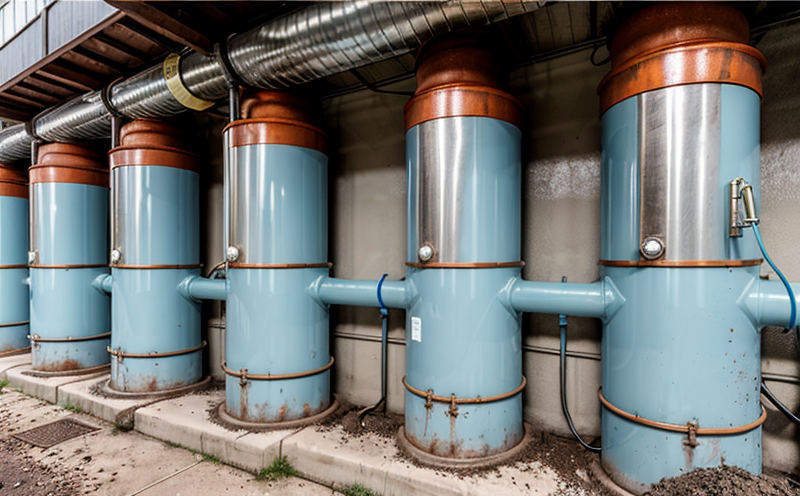ASTM D2681 Deposit Fouling Potential Test in Water
The ASTM D2681 Deposit Fouling Potential (DFP) Test is a critical procedure used to assess the likelihood of deposit fouling within water systems. This test is essential for industries that rely heavily on water quality and flow, such as power generation, cooling towers, and desalination plants. The primary goal is to predict how materials in a water system could contribute to fouling, which can lead to reduced efficiency, increased maintenance costs, and potential safety hazards.
The test involves exposing a material sample to water under controlled conditions that mimic real-world scenarios. The exposure duration typically ranges from 14 days to several weeks, depending on the specific requirements of the application. During this period, any deposits or fouling materials are quantified using various analytical methods such as gravimetric analysis and optical microscopy.
The ASTM D2681 test is particularly relevant for materials used in contact with water systems, including metals, plastics, rubber, and coatings. By understanding the potential for fouling, manufacturers can optimize material selection to enhance performance and longevity of their products. This testing procedure helps ensure compliance with industry standards such as ISO 9001:2015 and ASME PCC-3.
For quality managers and R&D engineers, this test provides valuable insights into the behavior of materials in water environments. The results can guide material development and selection processes to minimize fouling risks. Compliance officers benefit from ASTM D2681 as it supports regulatory compliance for industries with stringent water quality requirements.
Why It Matters
The importance of the ASTM D2681 Deposit Fouling Potential Test cannot be overstated, especially in sectors where water quality and flow are critical. Fouling can lead to significant operational issues, including:
- Reduced Efficiency: Fouled systems require more energy to maintain optimal performance.
- Increased Maintenance Costs: Regular cleaning and maintenance become necessary, adding to operational expenses.
- Potential Safety Hazards: Fouling can lead to blockages or other issues that compromise system integrity.
By conducting ASTM D2681 testing early in the development process, manufacturers can identify potential fouling risks and take proactive measures to mitigate them. This not only enhances product performance but also contributes to a safer working environment for all stakeholders involved.
The test is particularly relevant for industries such as power generation, where cooling towers are susceptible to fouling from minerals and other materials present in the water. Understanding these risks allows for better design choices that can prevent costly downtime and safety issues.
Quality and Reliability Assurance
ASTM D2681 is a cornerstone of quality assurance programs, ensuring that materials used in water systems meet strict standards for performance and reliability. The test focuses on the potential for deposit fouling, which can significantly impact system efficiency and longevity.
- Gravimetric Analysis: This method measures the mass change of samples exposed to water over a specific period. It provides quantitative data on the amount of deposits formed.
- Optical Microscopy: Used to visually inspect sample surfaces for deposit formation and composition, offering qualitative insights into fouling patterns.
The test results are typically reported in terms of weight gain or loss, surface area coverage, and microscopic images. These metrics help manufacturers make informed decisions about material selection and optimization. Compliance with ASTM D2681 ensures that products meet international standards such as ISO 9001:2015 for quality management systems.
For R&D engineers and procurement professionals, the test results provide critical data on how materials behave in water environments. This information is invaluable for product development and supplier evaluation processes. By ensuring that all materials are tested according to ASTM D2681, companies can maintain high standards of quality assurance and reliability.
Use Cases and Application Examples
- Cooling Tower Design: ASTM D2681 helps engineers design cooling towers that are resistant to mineral fouling, ensuring efficient heat transfer.
- Desalination Plant Optimization: The test is used to select materials for desalination plants that minimize biofouling and scaling.
- Petrochemical Industries: ASTM D2681 assists in selecting piping and equipment materials that withstand harsh water environments, reducing fouling risks.
In the petrochemical industry, for example, ASTM D2681 is used to evaluate the suitability of materials for use in pipelines transporting hydrocarbons. The test ensures that these materials can withstand the corrosive nature of the fluids while minimizing the risk of deposit fouling. This not only enhances operational efficiency but also extends the life of equipment and infrastructure.
Another application is in the power generation sector, where cooling towers are exposed to mineral-laden water. By using ASTM D2681 results, engineers can select materials that prevent scale formation and biofouling, leading to more efficient and reliable systems.





